CSF is proud to announce the release of its highly anticipated MQB cooling components. Finally, an aftermarket high-performance cooling solution now available to tackle the many overheating issues that have plagued this otherwise great track-worthy platform. The Ultimate MQB cooling system, exclusively by CSF, is designed to keep engine water, as well as both transmission and engine oil temperatures in check and at optimal levels, even under the most demanding race conditions. By utilizing CSF’s new suite of coolers in either a 1, 2 or 3 piece configuration, it allows drivers the ability to unleash their car’s full potential for extended periods during racing conditions.
The MQB cooling package consists of the following “drop-in fit” all-aluminum components by CSF. Both utilizing CSF’s B-tube technology.
Radiator
A high performance / race-grade, all-aluminum, triple-pass engine water radiator (CSF #7084)
Fitment
Audi 8V A3 1.8TSi, Audi 8V S3, Audi 8S TT (2.0TSi), Volkswagen MK7 Golf GTi, Volkswagen MK7 Golf R, Seat 5F Leon Cupra, Skoda 5E Octavia vRS
DSG/Heat Exchanger
A high performance / race-grade, all-aluminum, quadruple-pass DSG transmission water-to-oil heat exchanger. This new component is multi-fit that can also be installed (with no modifications) as an upgraded auxiliary radiator for maximum cooling performance. (CSF #8132)
Fitment
Audi 8X S1, Audi 8V S3, Audi 8S TT (2.0TSi), Volkswagen MK7 Golf R, 5F Leon Cupra.
CSF’s MQB cooling package
High-performance all-aluminum, triple-pass engine water radiator (CSF #7084)
High-performance all-aluminum, quadruple-pass DSG transmission water-to-oil heat exchanger (CSF #8132)

The VW Mk7 Golf R and GTI are two of the most widely praised and popular hot hatches globally and for good reason. Not only are they applauded for their factory performance, but respond extremely well to modifications. For instance, power can be increased by ~30% with simple
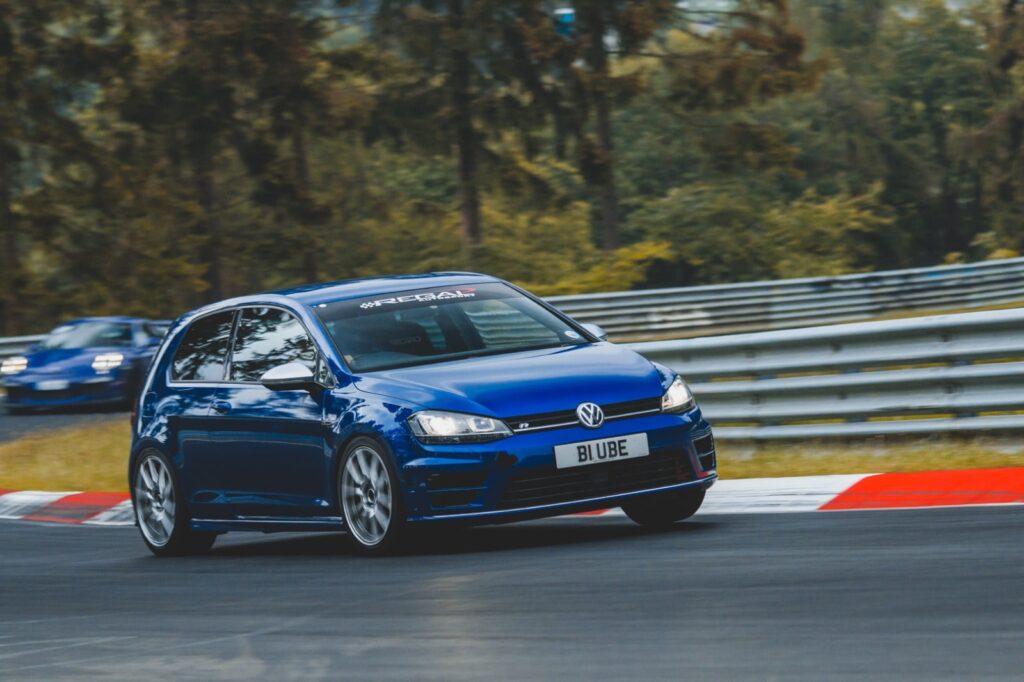
CSF HQ worked with CSF Europe manager Ash Stewart, who is the owner of a highly modified Mk 7 Golf R and experienced driver, to develop the MQB cooling package. The word came across to CSF that there was a tremendous gap in the marketplace for an easy to install / economical cooling solution to control DSG transmission temperatures during heavy track use in automatic transmission vehicles. As the cooling system experts, CSF was there to meet the challenge.
Before installing the upgraded CSF DSG heat exchanger, Ash was not able to push his car after several laps on the track because of high transmission oil temperatures. The transmission in his Golf R would start to feel sluggish, and he was forced to start
Observations from driving:
- Oil temperature seems to be consistently much lower by around 10-15°C (50-59°F), allowing me to use all of the revs all of the time without a care for oil temp. It sits at around 125°C (257°F) max now and I’ve never seen it go above 130°C (266°F) (this used to happen after around 2-3 “fast laps” with OEM set-up).
- Oil temperature now peaks and flat lines throughout the sessions. Before it would slowly grow to around 130°C (266°F) and then rise uncontrollably, very quickly and then not be able to cool down. Every time you would jump back on the throttle to drive fast, the oil temperature would spiral out of control again (talking 14°C+ (284°F with EASE).
Observations from logs:
- Engine coolant temperature does not go above 100.5°C (212.9°F)
What we can say for sure:
- Engine Oil Temperatures are reduced and maintained consistently during full load/rpm
- Engine coolant temperatures are maintained in the optimum range
- DSG oil temperatures rises and falls in line with the engine coolant temperature (well within ideal operating parameters)
Logged data from Ash’s track day testing after installing CSF’s new Ultimate Cooling Package.
Additional Track Testing / Auxilary Radiator – Players Show 2019

The MQB platform
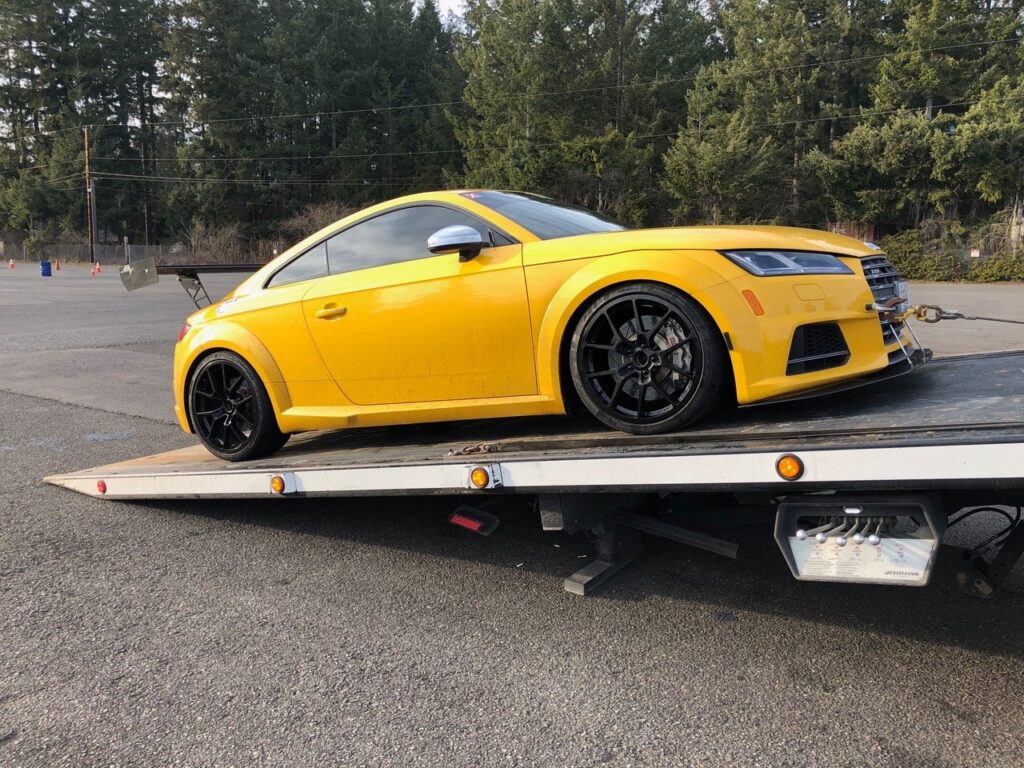
In these vehicles with 3 upfront water radiators (Center (Main radiator) Left, Right (DSG/Aux radiators). The coolant flows from the engine into the main water radiator. The coolant then splits into a Y piece, going into two auxiliary heat exchangers (small radiators). The right side auxiliary radiator is dedicated solely as a secondary means of lowering coolant temperature to maximize efficiency. The left side auxiliary DSG heat exchanger cools the automatic transmission fluid that is contained in an oil-to-water transmission cooler.
For best performance to both engine temperatures and transmission performance CSF recommends upgrading the main water radiator (CSF #7084), and the DSG heat exchanger (#8132). For maximum
@almost_racing_inc outfitted CSF team driver @zac_ross_racing‘s MK7 GTI with CSF’s High-Performance All-Aluminum triple-pass radiator (CSF #7084) and DSG heat exchanger (CSF #8132) on the left side of his vehicle. He’s opted to install one of CSF’s new bar/plate universal oil coolers on the right side of his VW GTI to directly tackle engine oil temperatures. (CSF #8119)
All the ducting, mounting brackets, and plumbing from
Radiator Comparison
CSF Unit
- 2-row 42mm (dual core) featuring CSF’s exclusive B-tube technology
- Core features an ultra-efficient fin with 6.5 mm fin height and multi-louvered design for maximum surface area contact
- Triple-pass flow structure allows the coolant to flow across the core of the radiator 3 times before exiting the radiator for lowest outlet temperatures possible
- CNC machined “quick-connect” inlet/outlet connections
- All-aluminum race style drain plug
- Smooth Satin Finish
- “Drop-in fit” requiring no modifications to install
OEM Unit
- 1-row 26mm core
- Single-pass
- 7mm fin height
- Plastic end tanks
CSF VAG MQB ALL-ALUMINIUM TRIPLE PASS WATER RADIATOR
Part Number
CSF# 7084 – Smooth Satin Finish
OEM Part Number
5Q0121251GN
Pricing
MSRP / MAP – $599.00
Fitment
- Audi 8V A3 1.8TSi
- Audi 8V S3
- Audi 8S TT (2.0TSi)
- Volkswagen MK7 Golf GTi
- Volkswagen MK7 Golf R
- Seat 5F Leon Cupra
- Skoda 5E Octavia vRS
DSG Cooler / Heat Exchanger Comparison
OEM Unit
- 26mm 1-row core
- Dual-pass design
- Plastic end tanks with plastic mounting pins (can crack under heavy vibration)
CSF Unit
- 2-row 42mm Core with CSF B-Tube Technology
- Quadruple Pass Design
- Removable metal Rock Guard
- Flow Area Increase = 42%
- Heat Rejection Increase = 36%
- CNC machined brackets and fittings for superb fitment and durability
- Fits both Left Side (DSG transmission heat exchanger) and Right Side (Auxiliary Engine Water)
CSF VAG MQB ALL-ALUMINIUM QUADRUPLE PASS DSG COOLER/HEAT EXCHANGER
Part Number
CSF# 8132 – Black Finish
OEM Part Number
5Q0121253H
Pricing
MSRP: $309.00 / MAP: $299.00
Fitment
- Audi 8X S1
- Audi 8V S3
- Audi 8S TT (2.0TSi)
- Volkswagen MK7 Golf R
- 5F Leon Cupra.
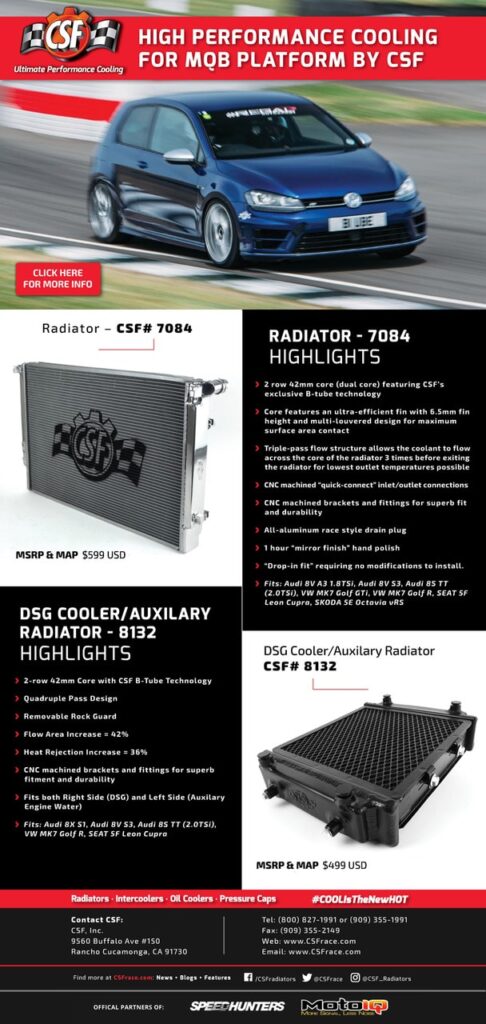
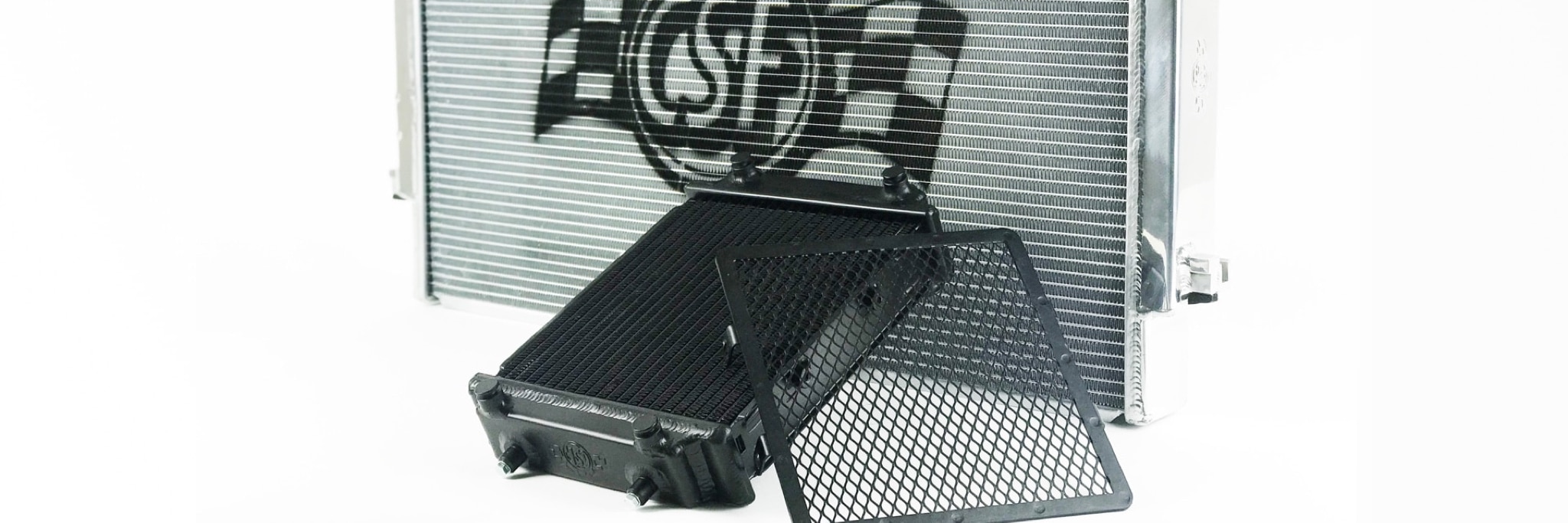
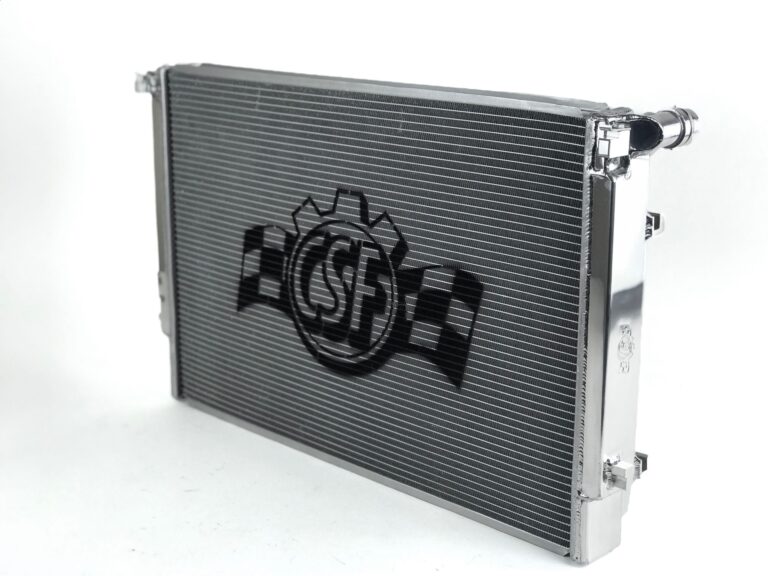
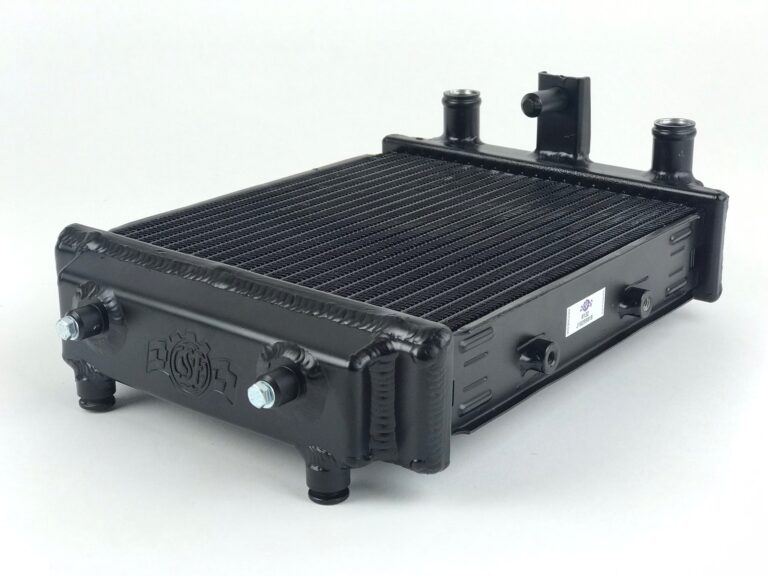


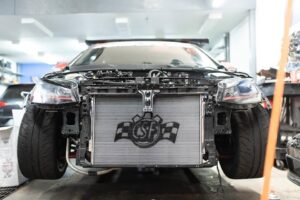
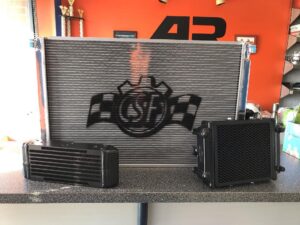

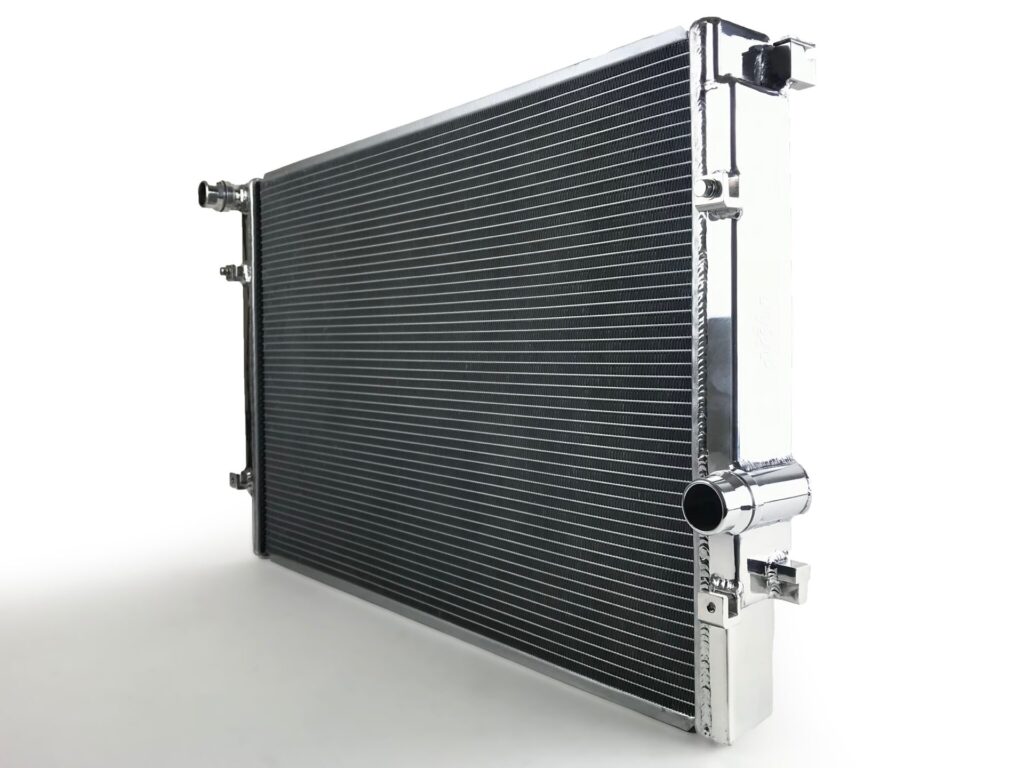




Hi. Have you compared real world performance of the CSF vs your do88 ?
A lot of people are asking the same question. The the do88 is actually a bit thinner than the CSF right ?
Please comment on performance.
Hi Collin,
We do not have any real world data on the do88 Radiator. We haven’t seen one installed here stateside or gotten feedback from customer who’ve had both. The CSF Radiator was track tested and developed in Europe with Regal Autosport so we have the published data from that in this blog post as you’ve seen. We have not seen anything similar from do88 but they might have something floating around online that we haven’t seen. All we can really do to help in this situation is compare the specs. I did this in another comment but here is the information:
Both the do88 and CSF Radiators use the same size and type cores. Both feature 2 row, 42mm thick cores in the triple pass configuration. The main comparison points between the radiators are as follows:
Cooling Fins:
– do88 features 5mm tall fins in a multi-louvered design
– CSF features 6.5mm tall fins in a multi-louvered design
While the smaller size fins means you can fit more cooling tubes in between, that doesn’t necessarily increase performance. The balance between fin density and fin height needs to be balanced for optimal air flow. While tube number does have an impact, tube design plays a bigger role in cooling efficiency. CSF has carefully tested an engineered our fin design, height, and density to optimize airflow and cooling.
Cooling Tubes:
– do88 cooling tubes details are unknown to us. Considering they don’t touch on this point we much assume they are the standard “O” style tubes.
– CSF cooling tubes feature our exclusive “B” Tube Technology.
These “B-tubes” are carefully formed and then brazed over the seam to seal. CSF is able to use thinner and lighter aluminum material (with better cooling efficiency) because this design is actually stronger than normal “O” shape tubes that are welded.
The design (inlet in the middle of tube that is seam brazed) increases the heat transfer surface area of the tubes by approximately 15% over regular tubes – producing the efficiency of two smaller tubes vs. one large tube within the same space criteria. With “B-tubes” you are able to get “dual liquid laminar flow”.
Manufacturing:
– do88 manufacturing in unknown to us and not published on their site. Most companies do not manufacture their products in house so we cannot speak to the quality level and manufacturing quality.
– CSF Radiators are all fully manufactured in house in our ISO 9001/9002 Certified Factories. CSF is a OEM grade manufacturer and contracts with companies like Mercedes-Benz – Commercial Truck, Isuzu Truck, John Deer, Caterpillar, Yamaha North America, Nissan North America (Nissan Performance Division & Nismo), Honda Performance Development (HPD), Vortech Superchargers, VF Engineering, Sheepey Race, T1 Race Development, Mountune, COBB Tuning, Full-Race, Titan Motorsports, And Many More. CSF has over 50 years of experience and over 40 million cooling systems sold globally.
Hopefully this helps you make the right decision for you and your build.
Is your radiator better than do88 mqb radiator ?
What are the main differences
Hi David,
Both the do88 and CSF Radiators use the same size and type cores. Both feature 2 row, 42mm thick cores in the triple pass configuration. The main comparison points between the radiators are as follows:
Cooling Fins:
– do88 features 5mm tall fins in a multi-louvered design
– CSF features 6.5mm tall fins in a multi-louvered design
While the smaller size fins means you can fit more cooling tubes in between, that doesn’t necessarily increase performance. The balance between fin density and fin height needs to be balanced for optimal air flow. While tube number does have an impact, tube design plays a bigger role in cooling efficiency. CSF has carefully tested an engineered our fin design, height, and density to optimize airflow and cooling.
Cooling Tubes:
– do88 cooling tubes details are unknown to us. Considering they don’t touch on this point we much assume they are the standard “O” style tubes.
– CSF cooling tubes feature our exclusive “B” Tube Technology.
These “B-tubes” are carefully formed and then brazed over the seam to seal. CSF is able to use thinner and lighter aluminum material (with better cooling efficiency) because this design is actually stronger than normal “O” shape tubes that are welded.
The design (inlet in the middle of tube that is seam brazed) increases the heat transfer surface area of the tubes by approximately 15% over regular tubes – producing the efficiency of two smaller tubes vs. one large tube within the same space criteria. With “B-tubes” you are able to get “dual liquid laminar flow”.
Manufacturing:
– do88 manufacturing in unknown to us and not published on their site. Most companies do not manufacture their products in house so we cannot speak to the quality level and manufacturing quality.
– CSF Radiators are all fully manufactured in house in our ISO 9001/9002 Certified Factories. CSF is a OEM grade manufacturer and contracts with companies like Mercedes-Benz – Commercial Truck, Isuzu Truck, John Deer, Caterpillar, Yamaha North America, Nissan North America (Nissan Performance Division & Nismo), Honda Performance Development (HPD), Vortech Superchargers, VF Engineering, Sheepey Race, T1 Race Development, Mountune, COBB Tuning, Full-Race, Titan Motorsports, And Many More. CSF has over 50 years of experience and over 40 million cooling systems sold globally.
Hopefully this helps you make the right decision for you and your build.
I have an octavia vrs mk3.5.
I also have an IE V2 intercooler installed. Would your CSF radiator still fit with the IE V2 intercooler ?
Hello Arjun,
If you did not have to modify the core supports that hold the radiator then it should fit just fine. The CSF Radiator fits in the factory location with no modifications, so if no modifications were made for the factory radiator mounting then they should not interfere with each other.
So the size of the intercooler doesn’t matter to the radiator. Doesn’t’ matter if it’s stock or if you have upgraded to a massive intercooler which is much thicker than the stock one. Is that correct ?
Sorry for the delayed reply. Correct, as long as the larger intercooler doesn’t take up any of the mounting space of the original radiator there should be no issues.
also with the stock intercooler ?
Hi, can the CSF Radiator fix onto a stock air intake / R600 air intake golf R mk7.5 DSG ?
Hi Alan,
The CSF Radiator (#7084) fits in the factory location perfect so there should be no interference with the intake scoop/duct that passes over it. It will definitely work perfect with the factory intercooler.
Will these fit the 2019+ Audi TTRS? If not – is there anything in the pipeline for them?
Can the DSG coolers be installed on a 2018 Audi RS3 8V, for both the right side (aux radiator cooler) and the left side (DSG cooler)? What are the estimated temp reductions when used in conjunction with the factory main radiator?
Hi,
Will this 7084 radiator fit golf R but with aftermarket IC – Airtec?
Thanks!
Yes it will
Will the DSG cooler fit on a Mk7 gti as well?
Hey Ron,
Thanks for reaching out! Our DSG Cooler for the Golf R can be ran on the Mk7 GTI when using the Golf R’s ducting, brackets, and plumbing.